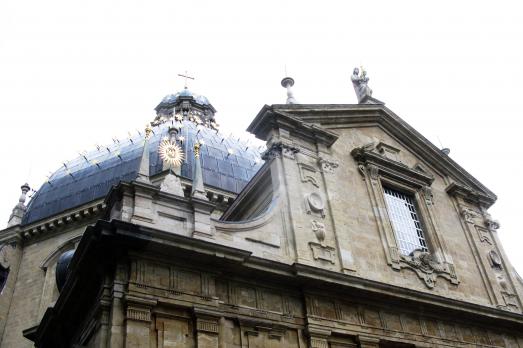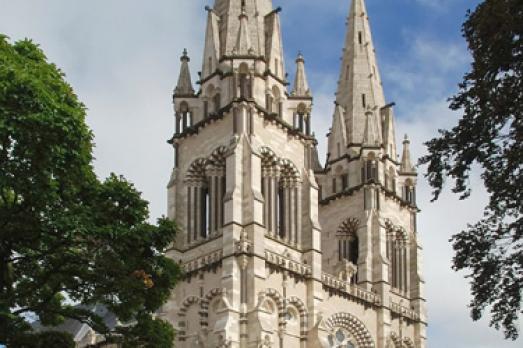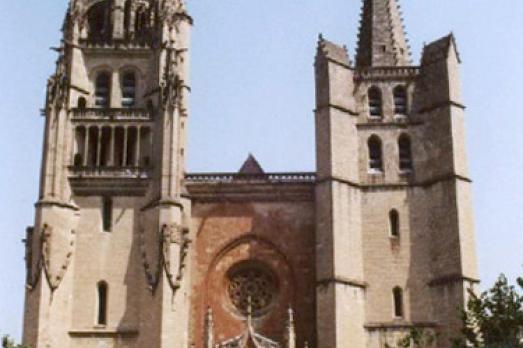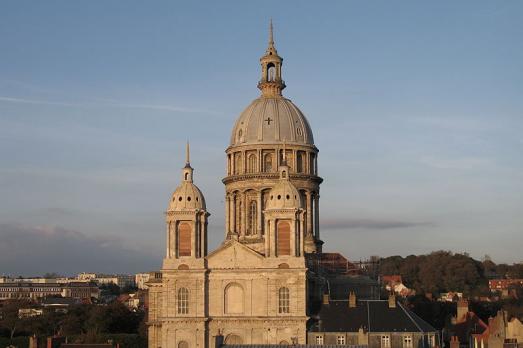Basiliek
Meerssen, NL
The Basilica of the Holy Sacrament in Meerseen was built in the 14th century. It was restored several times during the 19th and 20th centuries.
Here you can search for a building to visit. You can use the map find destinations, or you can use the filters to search for a building based upon what different criteria.
Meerssen, NL
The Basilica of the Holy Sacrament in Meerseen was built in the 14th century. It was restored several times during the 19th and 20th centuries.

Scherpenheuvel, BE
Reputedly the most visited shrine of pilgrimage in Belgium, this church was consecrated in 1627, and owes much of its beauty and status to the patronage of the Archdukes Albert and Isabela, and its role in the Counter-Reformation.
Schiedam, NL
Characteristic, exceptionally important, neo-Gothic church designed by EJ Margry, nicknamed Singelkerk. Built as the third Roman Catholic church in Schiedam, named OL Vrouw Rozenkrans, after St. Johannes de Doper (nicknamed Havenkerk, 1824) and OL Vrouw Visitatie (nicknamed Frankenlandsekerk, 1858, later named St. Liduinakerk). Since the end of the 1960s, after the decommissioning of those two earlier churches, this has been the only Roman Catholic parish church in the centre of Schiedam. After the demolition of the St. Liduinakerk from 1858, in 1969, the Singelkerk was named "OL Vrouw Rozenkrans en St. Liduina". After the church was elevated to a Basilica in 1990, it was named "St. Liduina Basilica", after the Schiedam saint Liduina.
Sint Odiliënberg, NL
According to tradition, an abbey was founded around 700 on a hill near the Roer by three monks from the British Isles : Wiro , Plechelmus and Otgerus . At the foot of that hill, the Sint-Petrusberg, the village of Sint Odiliënberg later arose. In 858, King Lotharius II donated this mons S. Petri and the monastery to Bishop Hungerus of Utrecht . During the time of the Viking raids, the monastery served as a refuge for the Utrecht clergy and remained a Utrecht enclave within the diocese of Liège for a long time afterwards . In the tenth century, the remains of Wiro, Plechelmus and Otgerus were 'elevated' by the Bishop of Utrecht, which in the Middle Ages was equivalent to canonization . From that time on, the three saints were venerated in the diocese of Utrecht.
Boxmeer, NL
Roman Catholic Church of St. Peter because of Oak oxal, 1634-37 carved by Jan Werkens from Venray. Five arches on grooved Corinthian columns; friezes and consoles with Renaissance ornament; above the cornice a balustrade with niches and statues of saints; in each of the two arches a panel with the coat of arms of Count Albert van den Bergh and one with that of his wife. Above the oxal a carved organ case from 1677 with the coats of arms of Count Oswald van den Bergh and his wife Maria Leopoldina, Countess of East Friesland and Rietberg. Marble grave monument, marked IB Xavery 1741, for Count Oswald van den Bergh (died 1712) and his wife Maria Leopoldina Countess of Rietberg (died 1718) in the form of a sarcophagus with obelisk and mourning putto with skull set into the wall. Bells: a bell called "Petrus", cast by Jan van Venlo in 1448, "Maria", cast in 1410, "Jhesus", cast in 1448.
Sittard, NL
Originally built as a church for the Ursuline monastery St. Calvaire, founded in 1843, for the purpose of educating girls. Large numbers of pilgrims in honour of a miraculous healing that took place here soon made the construction of a larger church necessary. This was built in 1875-'79 to a design by Joh. Kayser in neo-Gothic style. In 1883, the church was the first Dutch church to be elevated to Basilica Minor by the Vatican. In 1997, an extensive restoration took place.
Oudenbosch, NL
The initiator of this remarkable church in the 1860s was pastor Willem Hellemons. He was assisted by two parishioners: Theodorus Philippus Florschütz (1823-1886), 'drawing master' at the Saint Louis Institute and Jacobus Johannes van Tilborg (1830-1897), a local carpenter. Florschütz is credited with painting the penditives or spandrels of the large dome with the four Evangelists. The old St. Agatha Church in St. Bernaertstraat, Oudenbosch (1513, demolished 1882) was in poor condition and was becoming too small for the ever-growing number of parishioners. In 1865, work on the church was started, with the most famous Dutch architect of that time as its most important advisor: Pierre Cuypers (1827-1921). The church was built after the example of St. Peter's in Rome and consecrated on 14 September 1880 by Mgr. H. van Beek, the third bishop of Breda. The Antwerp sculptor Frans de Vriendt was responsible for 44 of the 50 large statues in the church, including the statue of Salvator Mundi on the front facade, which is over 4 metres high. The bell from the tower of the old church was put back into use in 1892.

Moulins , FR
Built in the 15th century and spread over many years.

Mende , FR
The construction of the church was decided in 1360 and was fully completed in the 19th century. It stands above the tomb of Saint Privat. During the war of religion, following an unsuccessful blackmail on the population who had to pay 4,000 ecus, the cathedral was destroyed.

Boulogne-sur-Mer, FR
The present basilica, under the name of Notre-Dame, was built in the 19th century on the ruins of a medieval building. The building rests on one of the largest crypts in France (100 metres long and with a surface area of 1,400m²), which was laid out during the construction work on the foundations of the Romanesque crypt.

new
Nestled amidst the serene landscapes of the Harz region, lies a hidden gem for nature enthusiasts and history buffs alike - the Harz Monastery Hiking Trail. Lace up your hiking boots and embark on this captivating adventure that will transport you back in time.

The Holy Mile (Miglio Sacro) of Naples is a one-mile-long itinerary, through sacred places linked to the city's patron saint, San Gennaro, in the Rione Sanità district. Discover the city from a new perspective with this unique walking tour.

As a university city, cultural offerings abound in Tartu and will reach their peak after being designated one of three European Capitals of Culture for 2024. In this list, we've compiled the most interesting sacred places to visit in and around the old town.